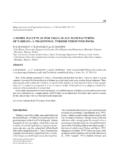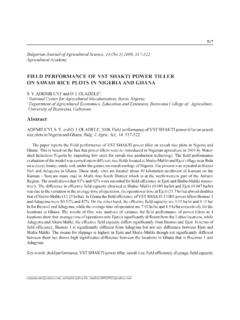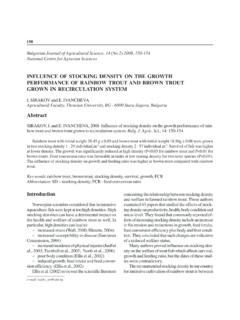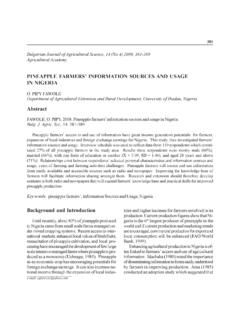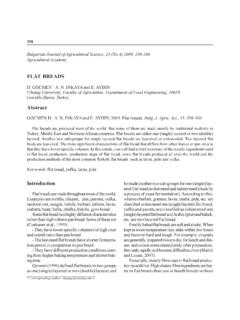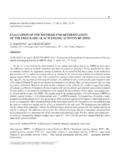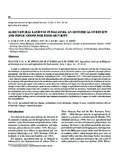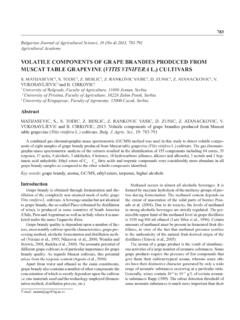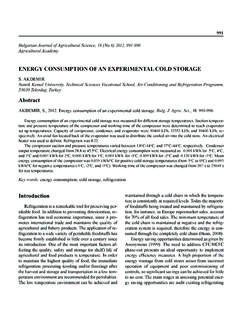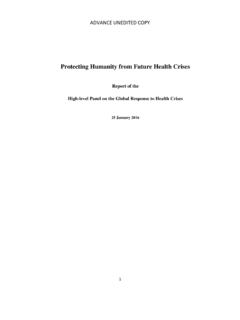Transcription of THE INFLUENCE OF ROW AND INTRA-ROW SPACING TO …
1 83 THE INFLUENCE OF ROW AND INTRA-ROW SPACING TO SEED YIELD AND ITS COMPONENTS OF WINTER SOWING CANOLA IN THE TRUE mediterranean TYPE ENVIRONMENTB. UZUN*, E. YOL and S. FURATA kdeniz University, Department of Field Crops, Faculty of Agriculture, TR-07058, Antalya, TurkeyAbstractUZUN, B., E. YOL and S. FURAT, 2012. The INFLUENCE of row and INTRA-ROW SPACING to seed yield and its components of winter sowing canola in the true mediterranean type environment. Bulg. J. Agric. Sci., 18: 83-91 The objectives of the study were to assess the effects of row and INTRA-ROW spaces to seed yield and its compo-nents and also determine the optimum row and INTRA-ROW SPACING for canola in order to obtain better yield in Medi-terranean type environment conditions. The field experiment was intended factorial randomized complete blocks design with three replications in West mediterranean Agricultural Research Institute s fields of Antalya at 2006-2007 and 2007-2008 growing seasons.
2 Rows were spaced of 10, 20, 30, 40 cm; intra-rows were spaced of 5, 10, 15, 20 cm with a registered canola cultivar. Traits such as seed yield, plant height, number of branches, stem height to the first pod, number of pods per plant, number of seeds per pods and 1000 seed weight were analyzed. The results indicated that row SPACING had a significant effect on seed yield, number of branches, number of pods per plant, number of seeds per pods in two growing seasons. The highest seed yield was obtained in 10 cm row SPACING along with 5-10 cm intra row SPACING . Number of branches, number of pods per plant and number of seeds per pods were affected negatively by narrow row spaces. Narrow row spaces affected seed yield, positively and strongly. Narrow row spaces are prerequisites for obtaining higher yields in canola in mediterranean -type words: Brassica napus L., canola, row SPACING , yieldBulgarian Journal of Agricultural Science, 18 (No 1) 2012, 83-91 Agricultural AcademyIntroductionCanola (Brassica napus L.)
3 Is an important oil-seed, which can be grown as winter and summer crop. It belongs to Crucifera family and is the most cultivated species in this family (Snowdon et al., 2006). Brassica napus L. originated from the Med-iterranean region of South-West Europe where the two contributing parents, B. oleracea and B. rapa, with natural hybridization (Saha et al., 2008). It has commercial importance with having high oil con-tent (about 30-45%) (Oad et al., 2001). Canola oil (low glucosinolate and erucic acid) originated high erucic acid rapeseed oil (Przybylski et al., 2005). Because high erucic acid caused to cardial prob-lems in humans (Gopalan et al., 1974 and Renarid *Corresponding author- e-mail: 84 B. Uzun, E. Yol and S. Furatand McGregor, 1976). Canola oil was developed which has low erucic acid and glucosinalates also known as double zero varieties made the canola oil more popular (Saleem et al.)
4 , 2001). In addition, higher unsaturated fatty acids and lower saturated fatty acids contributed to popularity of canola oil. Its production reached million metric tones and has become of third important oilseed crop about oil production after soybean and palm oil (USDA, 2008). Canola has a great advantage that it can be grown in winter unlike the most of the other oil-seed crops enabling it to no competition with other oilseed crops. It has therefore made the crop that is grown in the many parts of the world. Apart from canola is cultivated as winter crop in the Europe and Asia, it is cultivated only spring form in Can-ada, Northern Europe, and Australia (Snowdon et al., 2006). In Europe and Asia regions where have mediterranean climate, winter canola production has a great potential since it is an alternative to temperate cereals in the winter-spring growing season of temperate agricultural regions with no competition of other oil seed crops (Uzun et al.
5 , 2009). This provided constant production in a rota-tional cropping system throughout the agricultural systems, yield efficiency is af-fected interaction between genetic, agriculture and environmental factors. Soil type and salinity (By-bordi et al., 2010 and Hosaini et al., 2009), till-age method (Saglam et al., 2009), sowing time and method, seed rate, fertilizers, time of irrigation and row SPACING are some of these factors and very important for higher yield (Shahin and Valiollah, 2009). Row SPACING is important agricultural fac-tor and has great effect on seed yield and the yield components of individual plants (Diepenbrock, 2000). Canola seems that one of these individual plants and choosing appropriate row SPACING in winter canola helps in efficient use of available resources such as water, light and soil nutrients (Morteza et al., 2008). The previous researches showed that proper row SPACING affected seed yield and oil containing in cultivars (Oad et al.
6 , 2001), because different researchers clearly propounded this result for rapeseed in different regions of the world. Basalma (2006) reported that sowing den-sity affected to yield , positively. Ohlsson (1974) observed in Sweden, yield and oil content were lower when sown at 48 cm apart followed by 24 and 12 cm row SPACING . Christensen and Drab-ble (1984) and Morrison et al. (1990) obtained that narrow row spaces had more yield than wide rows in Manitoba and Alberta, respectively. Morteza et al. (2008) obtained maximum seed yield at the density of 80 plants m2 in Mazandaran, Iran. Ozer (2003) has indicated that 15 cm row SPACING have brought about 8-40% higher seed yield than 30 and 45 cm in Erzurum, Turkey. In Pakistan, although Oad et al. (2001) claimed that wide rows provided higher yield, Cheema (2001) observed that seed yield higher when narrow rows were used. This different result may arise from soil, seed and cli-mate differences.
7 In addition, plant establishment not only af-fected seed yield but also influenced plant char-acters, insects, weeds, diseases, soil environment, germination and emergency (Lauer and Rankin, 2004). Johnson and Hanson (2003) expressed that cultivar x row SPACING interactions affected plant height character which was greater when wide rows. Dosdall et al. (1998) identified, lower flea beetle damage to B. napus and B. rapa when sown at wider row SPACING . In case of disease and mois-ture, wider row SPACING was caused more mortality (Christensen and Drabble, 1984) and approximate-ly 200 plants/m2 significantly reduced the impact of weeds on canola yield (Odonovan, 1994).Canola is a pioneering crop for oil production. In order to obtain better yields in different environ-ments, agronomic practices should be identified for different climate zones. Therefore, the objective of this research was to evaluate the distribution of seed yield and yield components between row The INFLUENCE of Row and INTRA-ROW SPACING To Seed Yield of Winter Sowing 85and INTRA-ROW spaces of canola genotype grown in mediterranean type environment for obtaining higher seed yield in canola.
8 Material and MethodsThe research was conducted in the West Medi-terranean Agricultural Research Institute s fields of Antalya (36052 N. 30050 E. 15 m elevation) at 2006-2007 and 2007-2008 growing seasons to evaluate the effects of inter- and INTRA-ROW spac-ing on seed yield and yield components of canola (Brassica napus L.). A registered variety, Licrown, which has the best yield in the environment (Uzun et al., 2009) was used as a genetic material in the study. The crop was sown on 6th and 10th October of 2006 and 2007, harvested on 12nd and 18th May of 2007 and 2008, respectively. The experiment was set up in factorial randomized complete blocks de-sign with three replications. Four different row and INTRA-ROW SPACING were applied in the study. Row and intra row spaces were 10, 20, 30, 40 cm and 5, 10, 15 and 20 cm, respectively. The experimental area is located in the south-ern region of the country with hot in summers and mild cold in winters as a typical type of Mediterra-nean environments.
9 According to climate data, the experimental area was highly suitable for growing canola. The monthly rainfall, humidity and aver-age temperatures for 2006-07 and 2007-08 within the growing period of canola (October-May) are presented in Table 1. The highest rainfall was ob-served in October in 2006-07 and in December in 2007-08. Air temperatures and humidity were close to the long term averages during the two growing seasons but annual rainfall is different in the ex-perimental years. 2007-08 growing season was a relatively dry year and monthly rainfall during the growing season (October May) were lower than 2006-07 and long-term averages. Lower rainfall was monitored in the second experimental year caused to obtain relatively lower yields in all the intra and INTRA-ROW SPACING comparing to those of the first soil of the experimental field was alkaline clay ( ) with organic matter of Nitrogen, phosphorus and potassium were applied at a rate of 80 kg per hectare.
10 During the growth stages, weeds were removed by hand. Following to sowing, all the plots were irrigated once for encouraging emer-Table 1 Monthly temperature, humidity and rainfall values in the growing period of 2006-2007 and 2007-2008 MonthsTemperature, OCHumidity, %Rainfall, mm2006-20072007-2008 Long-term averages*2006-20072007-2008 Long-term averages*2006-20072007-2008 Long-term averages* *30 years86 B. Uzun, E. Yol and S. Furatgence. Seed yield (kg/ha), plant height, number of branches, stem length to the first pod, number of pods per plant, number of seeds per pods and 1000 seed weight measurements were taken in each plot. The obtained data were analyzed using SAS statis-tical package program (SAS Institute Inc., 1997). Means were compared by least significant differ-ences (LSD test).Results and DiscussionRow SPACING identified accurately has a large ef-fect on growth, development, seed yield and yield components of canola.
